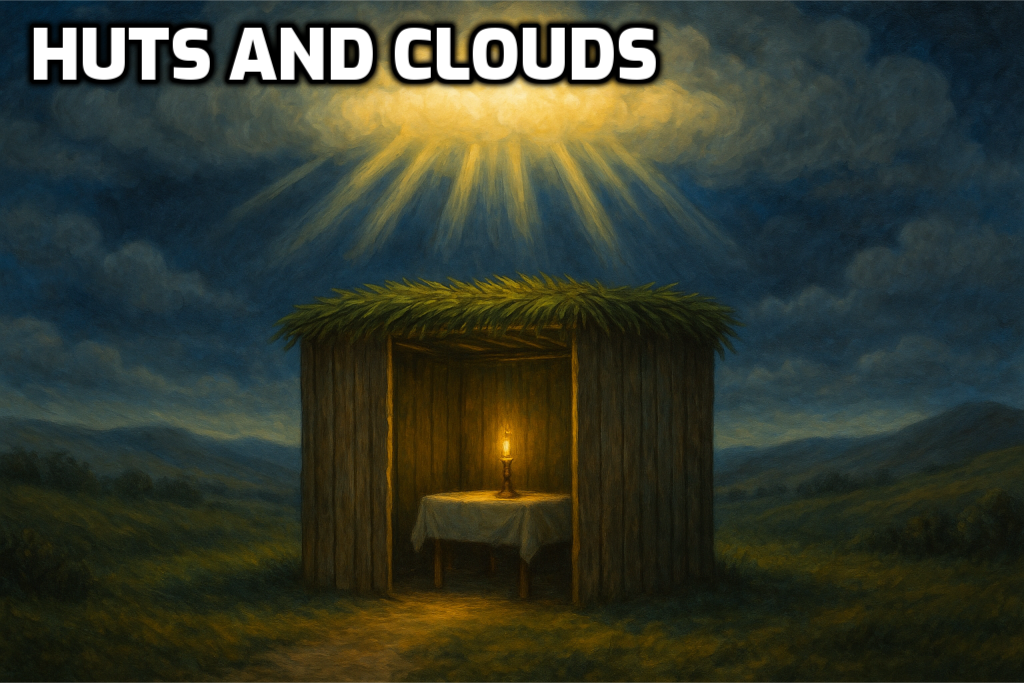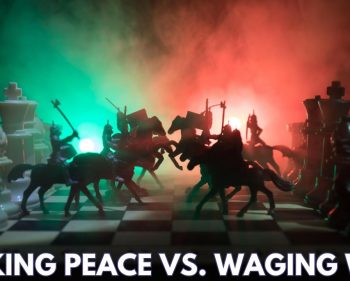HUTS AND CLOUDS

In June 1967, as the Six-Day War began, Israel’s leaders were genuinely terrified. The army was strong, but the coalition of Arab states surrounding them was overwhelming. In fact, a week before the war, military planners estimated that as many as 100,000 Israelis might be killed if Egypt, Syria, and Jordan attacked together. Mass graves were dug in public parks in Tel Aviv and Jerusalem, in case the unthinkable happened.
And yet, within six days, Israel not only survived, but utterly obliterated its enemies. The world was stunned. Military analysts were speechless. How could such a small, outnumbered country defeat three massive armies in less than a week? ‘
To Israelis, the answer was simple: and the answer can be found in the festival of Sukkot.
There’s a fascinating debate in the Gemara (Sukkah 11b) about what exactly the Torah means when it says (Lev. 23:43): כי בסוכות הושבתי את בני ישראל – “I made the children of Israel dwell in sukkot when I brought them out of Egypt.” In other words, why do we celebrate Sukkot?
Rabbi Eliezer says we celebrate Sukkot to remember the ananei hakavod — the miraculous ‘Clouds of Glory’ which protected the Jewish nation from the elements and from their enemies while they were in the wlderness.
But Rabbi Akiva says, no, what we are commemorating are the actual huts, physical shelters.
On the surface, it looks like a simple debate: one says clouds, the other says huts. But I think it’s not actually a debate at all. It’s two perspectives on the same reality.
When the Jewish people left Egypt and began wondering around the desert, they had to build temporary huts which could be easily dismantled and transported. After all, they needed to live somewhere, sleep somewhere, eat somewhere. So, they put up some sticks, created walls, made a rudimentary roof, and put together whatever shelter they could.
That was their effort. But what happened after they had done that made all the difference – because once they built the huts, God surrounded them with His clouds. The fragile huts were protected by a divine shield.
And that’s the formula of Jewish history: first you build, then God protects.
We see it in the sukkah itself. You and I go outside, we hammer some wood, we tie some canvas, we spread some palm branches or roll on some bamboo mats – and that’s the sukkah. Let’s be honest: if you or I were camping in Yosemite, and someone showed us a sukkah, we wouldn’t be too impressed. “You want me to sleep in this thing? It won’t even keep out a raccoon, never mind the rain.”
But once we’ve done our part — however flimsy it looks — God provides the rest. The sukkah becomes a virtual fortress, not because of its engineering, but because God’s presence rests upon it.
This is not whimsical theology. It’s what happened in 1967. Israel did everything it needed to in practical terms to prepare itself for the Arab onslaught, and God did the rest. Israel built a sukah, and God provided the Clouds of Glory.
It’s the story of Israel in 1967, and, truthfully, it’s the story of Israel from its inception in modern times. When Herzl gathered the first Zionist Congress in 1897, there was no state, no army, and no land. It was just an idea. A very fragile sukka. But Jews began to come. They drained swamps, they built farms, they revived Hebrew, they set up institutions, they were active diplomatically.
It all looked laughably vulnerable. The Ottomans initially dismissed the whole idea as mad. The local Arabs and absentee Arab landlords took Jewish money and were delighted – but they were sure that the whole thing would never work out. Even many Jews said it would never work. But the early pioneers kept building their sukka. And then, in 1948, the ananei hakavod appeared. God gave Israel His protection, and the State of Israel was born.
Rav Kook said this explicitly. He taught that waiting passively for the Messiah was not the Jewish way. We have to build. We have to do the work of kibbutz galuyot, of returning to the land, of reviving the language, of planting trees, of founding cities. That’s our sukka. And when we do that, Rav Kook said, Hashem answers by sending His ananei hakavod — the spiritual energy that moves history forward, that softens the hearts of nations, and that brings redemption closer.
Because here’s the thing: the hut always looks flimsy. That’s the point. Israel’s army may be amazing, but let’s be real — Israel is surrounded by 200 million people who don’t want Israel to exist. Every time Israel fights a war, however great the IDF may be, the odds are impossible.
In 1948, the Arab League invaded with seven armies against a few thousand young Jews with rifles. But they won. In 1973, Israel was caught off guard on Yom Kippur and suffered terrible losses. But they won. In 2023, October 7th brought a trauma so deep it shook the very core of our nation. hey’ve won. But after it all. Every time, Israel builds the sukka – and every time, God brings the clouds.
I’ll give you one more wartime anecdote. During the Gulf War in 1991, Saddam Hussein fired 39 Scud missiles at Tel Aviv and Haifa. Each one was packed with hundreds of kilos of explosives. Experts predicted thousands of casualties. And yet — miraculously — only a handful of people died directly from those missiles. Buildings were destroyed, but lives were spared. Journalists called it “the miracle of the Scuds.” Faithful Jews understood it as ananei hakavod.
And the same this time around, with missiles from Iran and Yemen causing relatively little damage and very few casualties, even when they landed. Because let’s be honest: Iron Dome and David’s Sling – that’s the sukka. The real protection is the ananei hakavod.
Rabbi Akiva and Rabbi Eliezer aren’t arguing. They’re complementing each other. We build our huts — weak, vulnerable, and fragile. And then God provides His clouds — strong, protective, and glorious.
That’s why Sukkot comes right after Yom Kippur. On Yom Kippur we admit we are fragile, we confess our mistakes, we strip away our illusions of control. And then, with that humility, we walk outside into a sukkah and say: “God, here’s our hut. Please surround it with Your clouds.”
Let me end with one more story. When Sir Moses Montefiore visited Jerusalem in the 1850s, he was horrified by what he saw. Hundreds of Jewish families, amounting to thousands of Jews – about 10,000 altogether – were crammed into the narrow alleyways of the Old City. Families lived six, seven, even eight people to a single dank room. The air was foul, sewage flowed in the streets, epidemics were common. And yet, for all its misery, Jerusalem’s Jews refused to leave the Old City walls.
Why? Because outside the walls, danger lurked. The hills of Jerusalem in the mid-19th century were not the bustling suburbs we know today — they were wilderness. Bedouin tribes and Arab marauders prowled the valleys, preying on anyone who ventured out unprotected. A traveler could be robbed, beaten, or worse. Wild animals – jackals and wolves – were not uncommon.
And beyond all that, living outside the walls meant living in isolation: if you were attacked, if you fell ill, if a fire broke out, no one could reach you in time. The Ottoman authorities offered little protection. For Jews, living inside the walls of Jerusalem — however cramped it was — felt like the only safety they had.
But Sir Moses had a different vision. He believed the future of Jerusalem lay beyond the walls. And so, in 1860, against all conventional wisdom, he funded the construction of a brand-new neighborhood just outside the Jaffa Gate.
He called it Mishkenot Sha’ananim — “Dwellings of Tranquility” — taking its name from a verse in Isaiah. It was a bold experiment: solid stone houses, with iron doors that could be bolted shut, and a flour mill to provide food and income.
But when the neighborhood was finished, no one wanted to move in. The houses stood empty. Families were simply too terrified. The walls of the Old City may have been suffocating, but at least they offered the illusion of protection. Beyond the walls, people imagined death waiting at their doorstep.
Sir Moses had to beg families to move in. He offered free housing, financial stipends, even special incentives for newlyweds. Slowly but surely, a few courageous Jews took the leap. They built their sukkah, so to speak.
And then something remarkable happened. The death and danger everyone feared never materialized. Life outside the walls blossomed. Families discovered fresh air, space, and health they had never known in the Old City. Mishkenot Sha’ananim thrived, and within a short time, new neighborhoods followed — Yemin Moshe, Nahalat Shiva, Mea Shearim, and many more.
What had looked like reckless folly became the foundation of Jerusalem’s rebirth. Montefiore had asked the Jews of Jerusalem to do their bit — to leave the illusion of safety behind and take a terrifying step into the unknown. And once they did, God wrapped them in His ananei hakavod.
The fragile experiment became a permanent reality. That little cluster of stone houses — Mishkenot Sha’ananim — became the seed of what we now know as West Jerusalem, a city that has grown into the vibrant, thriving capital of the Jewish people.
This Sukkot, as we sit in our fragile huts, let us remember that our strength is not in the wood or the branches, or the canvas and the fragile roof – but in the partnership. We build — and God surrounds us and protects us. That is the secret of our survival, and that is the promise of our future.

